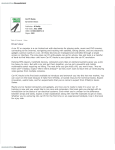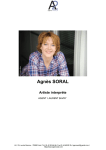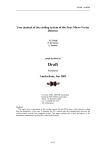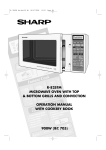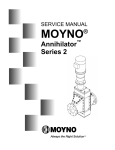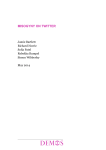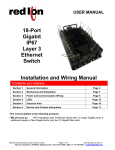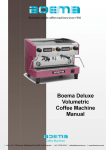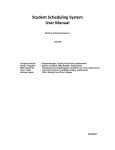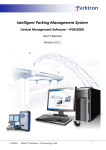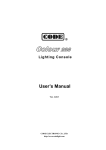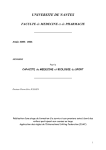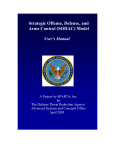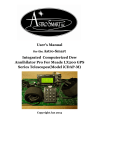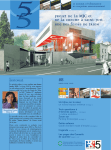Download xscorch(6) xscorch(
Transcript
Project XScorch
Team Core Dump
January 29, 2003
Change Record:
Date
Version
Changes/Additions
Responsible Person
1/29/03
1.0
Created document
Alon Gotesman
1/31/03
1.1
Fixed formatting of document
Alon Gotesman
2/4/03
2.0
Fixed up all the issues stated in
correction form, did more formatting,
and wrote battle section
Jeremy Stolarz
3/12/03
3.0
Removed mention of Team
functionality. Updated user interface
illustration
Alon Gotesman
1
TABLE OF CONTENTS
1) CREDITS-----------------------------------------------------------------------------------------3
2) OVERVIEW -------------------------------------------------------------------------------------3
3) PLATFORM -------------------------------------------------------------------------------------3
4) DEFINITIONS ----------------------------------------------------------------------------------3
5) GETTING STARTED -------------------------------------------------------------------------3
6) USER’S MANUAL -----------------------------------------------------------------------------4
6.1 - GAMEPLAY---------------------------------------------------------------------------------4
6.2 - INVENTORY --------------------------------------------------------------------------------4
6.2.1 – Weapons List --------------------------------------------------------------------------6
6.2.2 – Accessories List -----------------------------------------------------------------------7
6.2.3 – Tank list --------------------------------------------------------------------------------7
6.3 – BATTLE -------------------------------------------------------------------------------------7
6.3.1 – Tank Controls -------------------------------------------------------------------------8
6.5 - SYSTEM MENU -------------------------------------------------------------------------- 10
6.6 - AI PLAYERS ------------------------------------------------------------------------------ 11
6.7 - CONFIGURATION OPTIONS --------------------------------------------------------- 12
6.7.1 - Players/Rounds---------------------------------------------------------------------- 13
6.7.2 – Economics --------------------------------------------------------------------------- 13
6.7.3 – Physics ------------------------------------------------------------------------------- 15
6.7.4 – Landscape --------------------------------------------------------------------------- 16
6.7.5 – Weapons ----------------------------------------------------------------------------- 17
6.7.6 – Graphics ----------------------------------------------------------------------------- 18
6.7.7 - Gameplay Options ------------------------------------------------------------------ 19
6.7.8 - AI Controller------------------------------------------------------------------------- 19
6.7.9 - Sound Setup -------------------------------------------------------------------------- 20
6. 8 - COMMAND-LINE OPTIONS---------------------------------------------------------- 21
7) TRACEABILITY MATRIX---------------------------------------------------------------- 22
2
1) Credits
A majority of the following manual pages were composed by Justin David Smith,
<justins(at)chaos2.org> and are copyright(c) 2001,2000 A few isolated paragraphs were
cited from the Scorched Earth 1.5 tutorial, written by Wendell Hicken and copyright (c)
1991-1995. Team Core Dump enhanced and formatted this final version.
2) Overview
Xscorch is a clone of the classic DOS game, "Scorched Earth". Xscorch is an exciting
artillery combat game, where the goal is to destroy enemy tanks using powerful guns and
avoid getting killed using shields and other accessories. Using money won at the end of
each round, players purchase upgraded equipment, than target enemy tanks by adjusting
the angle and firing power of their turrets. The goal is to destroy enemy tanks before they
destroy you.
3) Platform
System Requirements:
Linux Machine
GTK+1.2 or better
Optional/Recommended:
Libraries MikMod (for sound) and GNOME
4) Definitions
AI: Artificial Intelligence. Computer players are capable of varying degrees of
“intelligence.” The lowest AI level is Moron, the highest is Insanity and in-between there
exist five separate and distinct difficulty levels.
Auto-Defense: An accessory item that can be purchased that allows the activation of
defensive accessories at the beginning of a round rather than during a player’s turn. This
allows a player to have shields, parachutes, and other accessories set up before shooting
starts, and therefore before possibly getting damaged or destroyed.
5) Getting Started
To obtain Xscorch visit the official website, located at
http://www.robotarmy.com/jeremy/cs115/ and download the latest version of the source
code. A window will appear, at which time you should select the “Save” option and place
the file in the desired directory. The code is in tarball form (*.tar.gz) so it must first
decompress it. Once this is completed and you have the ability to open all the files type
'./configure' to create the make file needed to compile the software. If you would like
networking capabilities you must compile the code using the command './configure -enable-network' instead. Next, 'make' to compile the file, and finally type 'make install'
3
to install the file. The game is now installed on your system! Type 'xscorch' to start the
game. Please refer to section “Command Line Options” for more command line options.
FILES
~/.xscorch/config
User's default configuration for xscorch.
xscorch.txt
Copy of this manual page. This file is installed to your local share directory, and
is used by the on-line help system.
copying.txt
Copy of the GPL. This file is installed to your local share directory, and is used
by the on-line help system.
tankprofiles
Profile bitmaps for the tanks, usually stored in the local share directory.
6) User’s Manual
6.1 - GAMEPLAY
We at Xscorch encourage the beginning user to experiment with the many options
in the main menu. Most of the options are straightforward, and you can begin playing
with only a little bit of information. A number of options (all which are explained later)
affect the difficulty of the game – note that the default options make for a reasonable
level of game play.
Most of the game configuration is controlled using menus, although a few are
command-line options, which are explained below. Once you are ready to begin a new
game, you may want to select “Save Options” to save your configuration, then select
Begin Game and start a new game.
Game play is divided up into a predetermined, player-selected number of rounds.
Each round consists of two phases: the Inventory Phase and the Battle Phase. In the
Inventory Phase, you can buy weapons to shoot at your opponents, and accessories to
help defend your tank. See the Inventory section below for information on the weapons
and accessories you may buy. In the Battle Phase, you setup defenses, select weapons,
aim and fire at your opponents. For more information refer to the section on Battle below.
6.2 - INVENTORY
Players have the option of buying different weapons and accessories, making for
more interesting games. Weapons are just that: an assortment of missiles, including
ICBM-like warheads, napalm, lasers and a number of custom weapons to bring down
specific defenses. Accessories increase a tank’s chance of survival, including guidance
systems, shields, fuel, batteries, parachutes, transporters, and other odds-and-ends.
4
At the beginning of a round, each player is given an opportunity to buy or sell
weapons and accessories. Each player is capable of carrying up to 99 of any item at one
time, with the exception of a few weapons that have an infinite supply (for example,
Baby Missiles). These weapons cannot be purchased.
Weapons and accessories are sold in bundles; the price of a bundle is displayed in
the inventory, and players must buy items as complete bundles. The exception to this is
when a player attempts to buy more of an item than their inventory can hold; in this case,
the bundles are detached and the weapons are sold on an individual basis, with a small
markup applied.
Players may also sell weapons and accessories in their inventory. Again, items are
generally sold as bundles. The player will receive a less-than-retail-value, salvage amount
of money for the sale.
In the Inventory screen, two panels are displayed, listing the weapons and
accessories available. There are several controls you can use at this point in the game:
TAB:
UP Arrow:
DOWN Arrow:
RIGHT Arrow
Switches between the various panes
Allow the player to scroll up through the list of items
Allow the player to scroll down through the list of items
Buy the highlighted bundle
5
Left Arrow
Sell the highlighted bundle
For each item, the name, bundle size/total price, and current inventory are displayed.
Items that can neither be bought nor sold will still appear. However, if the player
has maxed their inventory for that item, or they cannot afford to purchase the item, or
item has a higher arms level than the player is allowed, then the item is grayed out and
cannot be purchased. Items that can be bought will appear with an arrow pointing to the
right, and items that can be sold will appear with an arrow pointing to the left.
Xscorch item description are listed in the following two sections:
6.2.1 – Weapons List
Baby Missile
Missile
Baby Nuke
Nuke
Leap Frog
Funky Bomb
MIRV
Deaths Head
Annihilator
Napalm
Hot Napalm
Black Rain
Tracer
Smoke Tracer
Shield Sapper
Baby Roller
Roller
Heavy Roller
Riot Charge
Riot Bomb
Heavy Riot Bomb
Dirt Clod
Dirt Ball
Ton Of Dirt
A small triple turret capable missile that tanks
have in near infinite
A fairly large and inexpensive triple turret
capable conventional missile
A missile with a miniature tactical nuclear
warhead.
A missile with a tactical nuclear warhead
When this missile detonates the first two times,
it shoots out a new one.
The funky bomb is a very unpredictable cluster
bomb.
Multiple Independently targetable Re-entry
Vehicles. Branches multiple missile warheads at
apex of trajectory
A very large MIRV with nine nuclear warheads!
A missile with a huge tactical nuclear warhead.
A small globe filled with jellied gasoline.
A large globe filled with jet fuel.
Looking up, you see a flock of birds. No wait!
Those aren't birds... Branches multiple napalm
warheads at apex of trajectory
A missile with no warhead. Pretty useless.
A missile with no warhead that leaves a trail of
smoke.
A missile with a warhead designed to drain shields
it hits directly.
A weapon that rolls downhill and then detonates a
small warhead.
A weapon that rolls downhill and then detonates a
warhead.
A weapon that rolls downhill and then detonates a
large warhead.
Riot Charge!!!!
A bomb that clears dirt instead of damaging
players.
A bomb that clears lots of dirt instead of
damaging players.
Drop a small chunk of dirt on someone.
Drop a chunk of dirt on someone.
Drop a large chunk of dirt on someone.
6
Liquid Dirt
Drop a bunch of mud on someone.
6.2.2 – Accessories List
Baby Magnetic
Heavy Magnetic
Baby Shield
Shield
Heavy Shield
Baby Force
Force
Heavy Force
Fuel Tank
Triple Turret
Auto Defense
Solar Panel
Contact Trigger
Batteries
Parachute
Teleporter
6.2.3 – Tank list
Standard
Double Track
Fortification
A small low-power magnetic shield.
A large high-power magnetic shield.
A small physical shield layer.
A physical shield layer around the tank.
A large physical shield layer.
A small but impregnable force field.
A force field surrounding the tank.
A large heavy-duty force field.
Some fuel for a tank's motor will allow it to move
around.
A triple turret can shoot three of some missiles at
once.
Allows you to bring up shields at the beginning of
a round instead of during your turn
Solar Panels recharge shields slightly each turn.
With contact triggers, missiles will explode as
soon as they hit anything.
A tank's self-repair system needs batteries to run.
Restores 5% of tanks original health
Prevents tank from taking damage when it falls
Teleports tank to a new random location
Mobile, medium armor, medium fuel efficiency, medium base
size
Mobile, light armor, high fuel efficiency, smaller base size
Stationary, heavy armor, larger base size
6.3 – BATTLE
In its simplest form, the battle stage is when the players take turns inputting their
tank commands (see 6.3.1 – Tank Controls) in attempts to destroy one another. A
player’s turn lasts until he or she fires a weapon. Each round, a random turn order is
established and it repeats until the end of the round (when only one tank is left or when
no tanks are left). Exactly what occurs after a turn depends on whether sequential or
simultaneous game play has been selected (see 6.7.7 – Gameplay Options):
Sequential: In sequential mode, each player’s turn is resolved individually. In other
words, all inputted commands will take place when inputted and the shot fired will be
immediately resolved. Any changes the weapon causes to the landscape and/or damage
made to tanks is recorded, and if a player’s tank is destroyed, that player gets no more
turns until the next round.
Simultaneous: In simultaneous mode, each player takes his or her turn individually, but
the turns are all resolved at once. In other words, a player will input commands to the
tank, but will not immediately see the results. When everyone has inputted their
7
commands, then all commands are resolved simultaneously. Thus, all the tanks will fire
their weapons at the same time.
The main game screen shows tank locations and has a status bar on the top that
shows turret angle; shot power; what shield is selected and current power of the shield;
what weapon is selected; current life; the amount of batteries; contact triggers; fuel;
parachutes; and teleporters in the inventory; wind direction and strength; the current
round; and whose turn it is. This information is also colored to match the player’s tank
color.
6.3.1 – Tank Controls
Left, Right
Change the turret angle. This will adjust the turret angle in increments of 5
degrees. For finer control, hold Shift to adjust the angle in increments of 1
degree.
Up, Down
Change the firing power, in the range of 0 to 1000. This will adjust the firing
power in increments of 20. For finer control, hold Shift to adjust the firing power
in increments of 1.
8
Tab
Select the next weapon available in your inventory.
Shift+Tab
Select the previous weapon available in your inventory.
B, b
Activate a battery. A single battery can restore 5% of damage done to your tank,
and therefore restore the maximum firing power by 5% when you are damaged.
You must have a battery to discharge in your inventory to exercise this option.
E, e
Activate or energize the currently selected shields.
F, f
Activate your fuel tanks. A window will be displayed, indicating the amount of
fuel you have available. As long as you have fuel, you may use the Left and
Right arrows to move one unit to the left or right, respectively. In general, you
cannot move your tank up a steep hill. Immobile tanks will not be able to exercise
this option.
R, r
Force a redraw of the screen.
S, s
Toggle the currently selected shields. The currently selected shields are the
shields that will be used when you energize. Shields are classified by a power
number with a type suffix: M for magnetic shielding, F for force shielding, and S
for your standard, run-of-the-mill shields. If no shields are available, 0 is
displayed.
C, c
Toggle contact triggers on/off. This is only meaningful if you actually have some
contact triggers of course, and when tunneling is enabled. Weapons that are fired
after this point will have contact triggers equipped (until you run out).
T, t
Activates a teleporter, assuming at least one exists in a player's inventory. The
tank should disappear from the screen and reappear in a random location.
0–9
Display information about a particular player. 1gives information about Player 1,
and 0 gives information about Player 10.
Enter
Accept your orders.
9
Ctrl+Y
Bring up the System Menu (this can also be accessed from the menus). You can
control certain graphics options from the system menu, clear the screen of smoke
trails, and end a round prematurely.
Ctrl+Z
Pauses the game.
Ctrl+R
Resign from the game. This will end the game for everyone. You will be asked to
confirm the resignation.
6.5 - SYSTEM MENU
The system menu gives you some control over the game while it is in progress. In
this menu, you will have options to change how the game is displayed (e.g. the Graphics
Fast option described below). You also have access to a few useful commands, described
below. You can bring this up by pressing Ctrl+Y during the game or by using the menus.
Mass Kill
Kills everyone still alive in the round. No player gets credit for the kills, and none
are considered a suicide. This option is useful if all human players have already
been eliminated from the game, but the AI players are making no progress
whatsoever in annihilating each other. This option ends the current round only.
Erase Smoke
If you have used smoke tracers or have Trace Paths enabled, then this option will
clear all smoke trails from the sky.
Retreat
This feature is not yet implemented.
10
Resign Game
Resigns from the current round and all remaining rounds. This option ends the
entire game, and will take you back to the intro screen.
Sound Setup
Takes you to the Sound Options window. This will allow for both sounds/music
while the user is in the menu option screen. It will also allow sound-effect during
game play
6.6 - AI PLAYERS
Human
The humans believe they are the superior mind. The AI's rather disagree with that
sentiment. Keep this in mind when you are wondering why 9 AI's would want to
simultaneously target your tank...
Moron
This AI fires at random. Of all the AI's, this one has by far the highest suicide rate.
An alternate name is ``Cannon Fodder''.
Shooter
This AI goes for targets it has a line-of-sight to. It's not a great player otherwise.
This AI buys weapons that have the best economical yield, but during the game it
will select weapons that have the highest yield.
Spreader
This AI is similar to the Shooter, except a Spreader buys weapons with the highest
yield, without regard for the price.
Chooser
This AI chooses a victim. Once chosen, the victim is attacked until they are dead,
or the Chooser loses the ability to reach the victim. This AI does not need line-ofsight, but fortunately it cannot compensate for wind.
Calculator
This AI is like Chooser, except a Calculator can compensate for the wind. These
guys are fairly deadly in a fight; they also tend to allocate large budgets to defense
and offense.
Annihilator
This AI goes for weapons that will cause as much damage as possible, without
much regard for individual victims. This AI prefers spread weapons to the more
focused, precision weapons. A few Annihilators can clear the terrain easily. These
AI's don't worry about defenses too much. With their destructive tendency, they
won't survive long anyway - but neither will anyone else.
Insanity
11
This AI is very much like the Annihilator.
Economist
This AI focuses on a defensive strategy, buying the strongest available shields,
solar panels to replenish shields and sets auto-defense so the shields can be raised
immediately. Offensively, the opponent buys missiles and napalm to weaken
shields, than selects a single opponent (preferably one with shields) and attacks it
until it is eliminated. While the opponent still has shields, it will aim close to the
target rather than on target. Once shields are eliminated it will then shoot on target.
Unknown
This selects one of the above AI's at random, but you will not be informed which
AI was selected.
6.7 - CONFIGURATION OPTIONS
The following options can be set by selecting them from the main menu with
either the keyboard or the mouse. Once all options have been set, select “Begin Game”
to start playing.
12
6.7.1 - Players/Rounds
Number of Players (integer, 2-10)
Set the number of players participating in the game.
Number of Rounds (integer, >= 1)
Set the number of rounds to play for this game.
AI Type (list)
Select the AI type. Human players are ``Human''; the remaining AI's are
documented above.
Player Name (string)
Give a unique name for each player.
Tank Style (list)
Select the type/shape of the tank, for each player.
6.7.2 – Economics
13
Scoring (list)
Specifies in what manner each player scores points (money) at the end of each
round:
BASIC scoring:
Players receive points only for killing tanks and
surviving a round.
STANDARD scoring: Players get less points for actually killing a tank, but
get points every time they damage a tank or shield.
GREEDY scoring:
Works like STANDARD scoring, but the final
rankings at the end of each round are based on the Net
Worth of your tank, e.g. how much cash you have in
the bank plus the depreciated value of all weapons,
etc. in stock ("He who dies with the most toys wins").
Initial Cash (integer, 0-1000000)
Amount of money each player should start with.
Interest Rate (float, 0-0.30)
The interest rate for savings, compounded once per round.
Dynamic Interest (toggle)
If enabled, interest rates will change during the game.
Computers Can Buy (toggle)
If enabled, computers are permitted to buy items. The AI's are very uninteresting if
this option is turned off.
Computers Buy Aggressively (toggle)
If the previous option is enabled, the AI's will buy items conservatively. With this
option, the AI's will allocate larger budgets and buy bigger items early in the game.
Free Market (toggle)
14
In Free market play Equipment and weapons are affected. When the game initially
begins the prices are set. After the initial round prices begin to adjust depending on
what the demand is for the item. For example of a person constantly buys Napalms
the price every round will go up. There are set grounds for the prices (the price of
an item will not go less then this set price).
The Lottery (toggle)
If the lottery is enabled, there will be a random drawing at the start of each round.
A random player will receive a bundle of a random weapon for free as the lottery
award. This is a great way to inject a little extra life into AIs who are usually
conservative buyers. Plus it's always great fun when you get a free Annihilator...
6.7.3 – Physics
Air Viscosity (float)
This feature is not yet supported
Gravity (float, 0-10)
Specify the gravity, in pixels per cycle squared (one cycle is roughly 50
milliseconds).
Ground Damping (float, 0-10)
Specify the ground damping, used in tunneling calculations.
Maximum Wind Speed (float, 0-10)
Specify the maximum wind speed, in pixels per cycle squared. The actual wind
velocity is initialized once per round, to some value in (-max, max).
Suspend Dirt (percentage)
This feature is not yet supported
15
Tanks Fall (percentage)
This feature is not yet supported
Borders Extend (integer, >= 0)
This specifies how far off-screen weapons should be tracked, when you are
playing with no walls. When this value is zero, weapons will disappear as soon as
they leave the screen in the horizontal direction, even if wind would have brought
them back on-screen.
Walls Are (list)
Specify how weapons behave when they hit a boundary. Note, boundaries are not
always ``concrete'' -- this specifies how the sides and ceiling behave:
None
The sides and ceiling are open.
Concrete
All sides are solid. Weapons hitting any boundary will
explode.
Padded
Weapons hitting the sides and ceiling will bounce off,
although at a reduced velocity.
Rubber
Weapons hitting the boundary will bounce off at exactly the
same velocity.
Springy
Weapons hitting the boundary will bounce off with an
additional “kick” to the velocity.
Wraparound
The ceiling is open. Weapons going off one side will
reappear on the opposite side. Explosions will also wrap
around the screen if they detonate near an edge.
Random
One of the above types of walls is selected at random.
Wind is Dynamic (toggle)
Normally the wind remains constant through a round. If this is enabled, the wind
will change once per turn.
6.7.4 – Landscape
Land Generator (list)
Specify the generator to use to create the land.
Bumpiness (percentage)
16
Specify the noise on the generated landscape.
Sky (list)
Specify the background sky.
Hostile Environment (toggle)
When selected, hostile environments in the form of meteors or lightning bolts.
These hazards appear random times and hit random spots, producing the same
amount of damage as baby missiles to both land and tanks. Shields act on
environmental hazards just as they do on any other projectile.
6.7.5 – Weapons
Arms Level (integer, 0-4)
Specify the maximum arms level for the game. Only weapons with this arms level
or lower may be purchased by any player, under normal circumstances.
Bomb Icon Size (integer, 0-4)
Specify the size of the bomb icons, while they are traversing their path in the sky.
This does not affect the size of explosions, or the size of the smoke paths (if trace
paths is on).
Scaling (float)
Scale the size of explosions by this value. If playing on a very large or very small
playing field, you might want to adjust this value.
Tunneling (toggle)
If set, weapons are allowed to tunnel through land. If you enable this, you will
want to buy contact triggers if you want a particular weapon to always detonate on
impact (instead of tunneling through land).
Trace Paths (toggle)
If enabled, all weapons leave a smoke trail to reveal their trajectory. If this option
is off, you can still use Smoke Tracers to determine the path a weapon will take.
17
Useless Items (toggle)
Some weapons are not useful given the current configuration (e.g. contact triggers
are irrelevant if tunneling is disabled). If this option is enabled, then weapons that
will have no effect are not listed in the inventory screens.
6.7.6 – Graphics
Screen Width (integer)
Set the width of the playing field, in pixels.
Screen Height (integer)
Set the height of the playing field, in pixels.
Dithering (toggle)
If enabled, the land and sky gradients will be dithered. This option is particularly
useful on 16-bit displays, where the gradient is very noticeable otherwise. This
does slow down land generation somewhat.
Animation (toggle)
If enabled, explosions and other effects will be animated. This option can also be
controlled from the System Menu.
Graphics Are Fast (toggle)
If enabled, all graphics are always as fast as possible. This option can also be
controlled from the System Menu.
Computers Are Fast (toggle)
If enabled, graphics are fast when there are only computer players alive. This
option can also be controlled from the System Menu.
18
6.7.7 - Gameplay Options
Mode (list)
Determines if all players will fire at once (Synchronous), or whether each player
will fire independently (Sequential).
Order (list)
Determines the player order.
Talk Mode (list)
Determines who is allowed to talk.
Talk Probability (percentage)
Determines the likelihood that a player will speak at the end of a turn.
Extended Status (toggle)
If set, the status bar will contain an additional row of extended information during
the game (things such as trigger, battery, parachute, and teleporter inventories;
life; and wind).
Tooltips (toggle)
If set, tool tips will be displayed where available.
6.7.8 - AI Controller
19
Human Target Practice (toggle)
AI's will always prefer human targets to AI targets (except for AI's that fire at
random). When playing against 9 Calculators, this can make your day pretty
lousy.
Allow Offset Targeting (toggle)
Generally, when a weapon hits a shield it does less damage than an explosion
detonating right outside the shield (weapons hitting the shield do not have a
chance to detonate). This changes the AI targeting behavior so they will
deliberately aim outside the shield, if their intended victim has raised shields.
Always Offset (toggle)
If the above option is set, this option will force the AI to always offset its
targeting as if the player had raised shields. This allows the AI to compensate for
cases where the player may simply not have had their turn yet to raise shields.
The downside is the AI will never attempt to score a direct hit with this option
enabled.
Enable Scan Refinement (toggle)
If set, harder AIs are allowed to refine their trajectories by computing trajectories
that take into account player shielding effect and various other factors they do not
normally consider. This option could slow down game play a bit but makes the
AIs much more difficult.
No Budget Constraints (toggle)
AI's will spend as much money as they can, disregarding their budget preferences.
6.7.9 - Sound Setup
20
Enable Sound (toggle)
When set, music and sound effects will be played.
Use HQ Mixer (toggle)
When set, mikmod's high-quality mixer will be used.
6. 8 - COMMAND-LINE OPTIONS
--help
Display a brief synopsis of the command-line options available.
--insanity
This is insanity, Max! Or what if it's genius?
--yields
Display weapon yields, and economical yields.
--geometry=wxh
Specify an initial window geometry for xscorch, where _w is the width and _h is
the height of the playing field. This is useful for displays less than around
800x600 resolution. Note this option over- rides the settings in the config file, but
you can save the new options to your config file so you don't have to specify this
every time. You may also use -g.
--config=file
Load an alternate user config file, in file.
--sound
Enable music and sound effects. You may also use -S.
--nosound
Disable music and sound effects. You may also use -s.
--hqmixer
Enable use of the high-quality mixer, if sound is enabled. This may use a lot of
CPU power on older machines.
--nohqmixer
21
Disable use of the high-quality mixer, if sound is enabled.
--name
Set the name of your player, if you are initiating a network game. By default,
your user name is used.
--port
Set the port number to use in a network game. This option is only relevant if you
also specify --client or --server. The default is dependent on the protocol number,
but is some large port number.
--client=server
Start Xscorch in client mode, and connect to server (which should already be
running). If --name and --port are not specified, reasonable defaults are used.
--server
Start xscorch in server mode, and wait for connections from the clients. --name
may be used in conjunction to specify the name of this player.
7) Traceability Matrix
Requirement #
1.1-1.5
2.1, 2.6
2.2-2.5
Manual Section(s)
6.6
6.7.2
N/A
3.1-3.2
3.3-3.4
6.7.2
N/A
4.1-4.2
5.1-5.5
6.1-6.3
6.4
6.5
7.1-7.2
7.3, 7.5
7.4
8.1-8.3
8.4-8.8
N/A
6.7.4
6.2.2
N/A
4
6.2.2
6.3.1
N/A
6.7.7
N/A
Comments
Programming issues, rather
than feature issues.
Must code new calculation
and display methods
Technical issues.
GTK drawing issue
Coding issue
New programming, design and
scoring issues
22






















